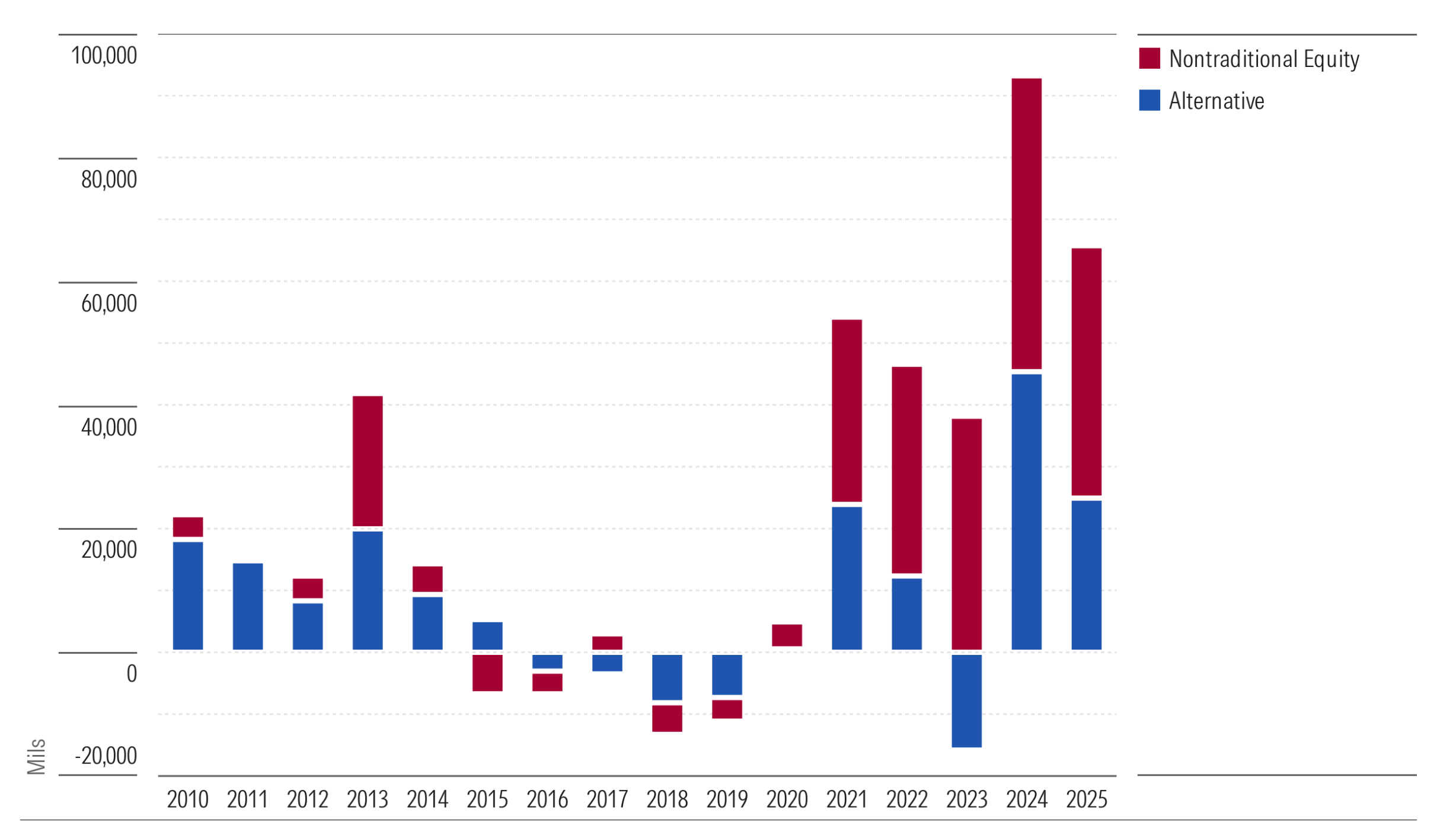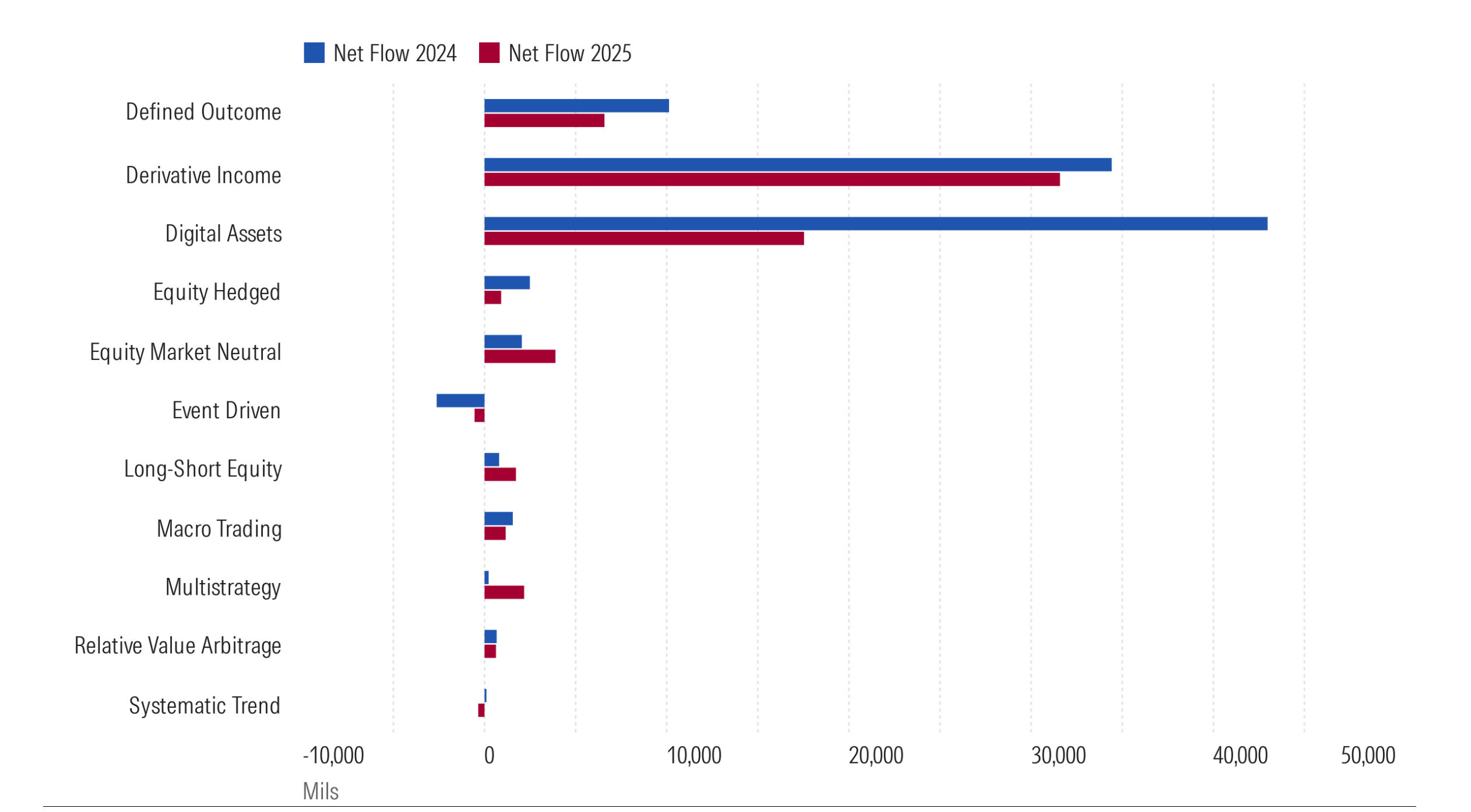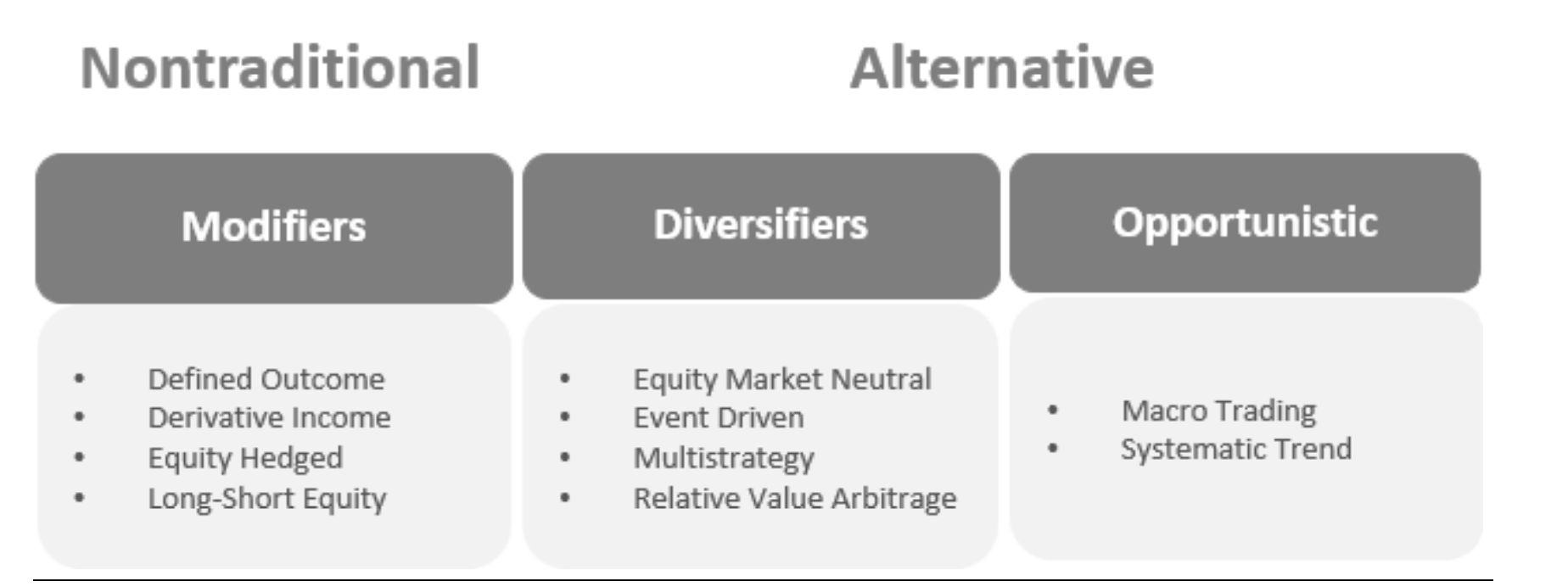7 min read
Top Trends in Alternative Investments and Asset Flows

On this page
On this page
On this page
On this page
Nontraditional equity and liquid alternative strategies saw record inflows in 2024, a trend that continued into the first half of 2025. To take advantage of these strategies, investors need to be able to unpack the complexity that often obscures these funds' challenges and higher risk profile.
Without a clear perspective, investors often struggle to form realistic expectations that could help them stick with the funds through thick and thin.
The 2025 US Liquid Alternatives Landscape explores how alternative investments are reshaping portfolios and what this means for investors navigating an increasingly complex market environment.
How Alternative Investments Are Reshaping Portfolios in 2025
The surge in alternative investments reflects investors' growing sophistication in managing risk and seeking uncorrelated returns. Nontraditional equity and alternative funds in the US are on track to eclipse 2024's record flows, having drawn a combined $92 billion during the previous year. This momentum continued into 2025's first half, demonstrating sustained appetite for these strategies.
US Morningstar category group asset flows

Source: Morningstar Direct. Data as of June 30, 2025
Which Alternatives Are Most Popular in 2025?
Digital assets drew $43 billion in 2024, helped by regulatory changes that opened new doors for investors. In January, the SEC approved bitcoin for trading on stock exchanges, making it far more accessible to institutional and retail investors. This regulatory change helped fuel the digital assets boom, with BlackRock's iShares Bitcoin Trust ETF alone attracting $37 billion in flows.
Derivative income strategies followed closely, pulling in $34 billion, while defined-outcome funds added another $10 billion.
US Morningstar category asset flows in 2024 and 2025 through June

Source: Morningstar Direct. Data as of June 30, 2025
The popularity of derivative income and defined-outcome strategies reflects investors' desire to customize their portfolio risk profiles. These methods allow investors to tailor specific return outcomes while managing volatility and defining their downside risk in an uncertain environment.
What Are the Types of Alternative Investments?
Morningstar analysts organize liquid alternatives into three broad groups to help advisors meet objectives: modifiers, diversifiers, and opportunistic strategies. This classification system allows advisors to set appropriate expectations and understand how different alternatives function within a portfolio context.

Modifiers: Adjusting, not eliminating risk
Modifiers correlate with traditional risk factors but use derivatives or hedging to reshape portfolio characteristics. They typically maintain net long exposure while aiming to reduce volatility or enhance risk-adjusted returns.
Derivative income strategies use covered-call writing and other options overlays to generate income while keeping equity exposure. With betas between 0.6 and 0.9, they remain sensitive to markets but offer some downside protection.
Equity long-short strategies hedge long holdings with short positions while keeping overall market exposure. With betas between 0.3 and 0.8, they modify rather than eliminate equity risk, making them complements to core allocations.
Advisor glossary
Covered call: Selling an option that allows another investor to buy a stock you already own, typically used to generate income.
Beta: A measure of how closely a strategy’s returns move with the broader market. A beta of 1 means it moves in line with the market; less than 1 means lower sensitivity.
Long position: Buying a stock with the expectation that its price will rise.
Short position: Borrowing and selling a stock with the goal of buying it back later at a lower price to profit from a decline.
Diversifiers: Seeking uncorrelated returns
Diversifiers look beyond traditional stocks and bonds, tapping into volatility, interest rate differentials, or market-neutral value.
Equity market-neutral strategies balance long and short positions to strip out systematic risk, profiting mainly from stock selection.
Event-driven strategies pursue opportunities in corporate actions like mergers or restructurings.
These strategies typically carry betas below 0.3, offering genuine diversification, though correlations can rise in market stress.
Opportunistic strategies: Capital preservation in shifting markets
Opportunistic strategies focus on absolute returns, moving between long and short exposures as opportunities arise. They often perform best during volatile or disruptive environments.
Global macro-trading funds make directional bets across asset classes based on macroeconomic trends.
Systematic trend strategies (managed futures) adjust exposures using momentum signals across global markets.
These approaches may appear modest in stable conditions but can deliver outsized results in dislocations, helping portfolios withstand stress.
Digital assets fall outside this framework because of their volatility and unproven diversification benefits.
What Are the Risks Associated with Alternative Strategies?
Alternative investments carry unique risks that investors must understand before integration into portfolios. These strategies are designed for diversification and capital preservation rather than return maximization, requiring realistic expectations about their role and potential outcomes.
These strategies often use sophisticated instruments and techniques, including hedge funds, private credit, mutual funds, and real assets, as well as newer types of alternative investments. While they may provide diversification, investors must weigh the potential profit or protect against loss. This complexity can obscure underlying risks and make it challenging for investors to maintain conviction during periods of underperformance.
Liquidity considerations: While liquid alternatives offer daily redemption capabilities, underlying strategies may invest in alternatives such as private markets or illiquid securities that could face constraints during stressed conditions.
The correlation dynamics between alternatives and traditional investments can shift during market stress, potentially reducing diversification benefits precisely when they're most needed. This behavior requires careful portfolio construction and ongoing monitoring.
Alternative Investment 2025 Outlook
The alternative investment landscape continues to evolve as new strategies emerge and regulatory changes create fresh opportunities. Digital assets represent the most dramatic recent addition, though their long-term portfolio benefits remain to be proven.
Regime shifts in market conditions could significantly alter the value proposition of different alternative strategies. The prolonged period of low volatility and strong equity returns that favored traditional assets may give way to a more complex environment where alternatives can demonstrate their utility.
Developing new defined-outcome products and derivative structures provides investors with increasingly precise tools for customizing portfolio characteristics. These innovations allow for more targeted approaches to risk management and return generation.
Make Alternatives Work for You With Direct Advisory Suite
Success with alternatives depends on integrating strategies thoughtfully and setting realistic expectations.
Alternative strategies often behave differently from traditional assets; patience and conviction are essential. When used wisely, nontraditional equity and alternatives can strengthen portfolios, manage risk, and support long-term objectives.
Direct Advisory Suite helps advisors cut through the complexity of nontraditional equity and liquid alternatives, giving them the tools to evaluate, compare, and integrate these strategies into client portfolios with confidence.
Key capabilities for alternative investments include:
Investment research: Screen, evaluate, and compare liquid alternative funds. Use new filters to identify derivative-income, defined-outcome, and other strategies across the mutual fund and ETF universe.
Insights and industry research: Access Morningstar’s latest analysis and education on alternative strategies, supporting deeper client conversations.
Risk profiling and scoring: Build proposals and reports that show how liquid alternatives affect portfolio risk and diversification. Visualize exposure by strategy type and generate AI-assisted talking points.
Portfolio creation and analysis: Incorporate alternatives alongside traditional holdings. Capture client preferences, align with risk tolerance, and leverage the Morningstar Portfolio Risk Score to demonstrate trade-offs.
Direct Advisory Suite simplifies the complex, empowering advisors to unlock the potential of liquid alternatives in client portfolios.


